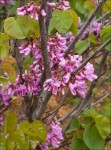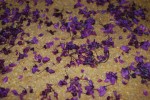Western Redbud
Western Redbud
-gardening blog by Darlene Ward
At the end of winter, our landscape is clothed in a subdued green of pines and a ghostly grey of dormant branches, grounded with the refreshing green of grasses started by winter rain. Gradually a purplish haze covers shrubs here and there, and then suddenly there is an explosion of a luscious shade of magenta.
Every spring I look forward to the beautiful magenta-pink blossoms of Western Redbud (Cercis occidentalis), a native in our foothills below 4,500 feet. Near where I live, these exclamation points are scattered along Highway 20 between Nevada City and Penn Valley. They can be seen at the side of Highway 49 in downtown Grass Valley, and there is an elegant one on the Buttermilk Bend Trail at Bridgeport.
Redbud goes through several intriguing stages. The ½ inch flowers emerge profusely on bare branches in early spring and are pollinated by bees. Heart-shaped, light green and bronze-tinted leaves that become dark green and then yellow, red or brown before dropping to the ground in the fall, quickly follow the blossoms. Flat 2-4 inch seedpods develop in the summer, changing from green to dark magenta and finally to brown, in which state they hang on the bush throughout winter and into the following spring. The typical pea shape of the blossom and the long seedpods are clues that redbud belongs to the Pea Family (Fabaceae).
In my garden, I grow Redbud as both a specimen plant and a “backbone” plant, providing basic structure to the garden along with other large shrubs. It grows 10 to 18 feet tall and wide and may be a multi-trunked shrub or trained into a small tree. I planted several redbuds, desiring repetition of color when they are in bloom. In five years, one plant has grown ten feet tall by about five feet wide, while another has remained dwarf. A third plant is six feet tall. None of them bloomed profusely in the first three years. I had looked forward to seeing rich magenta blossoms, but mine turned out to be light pink. However, the color is striking next to the blue Ceanothus that blooms at the same time.
Redbud is one of the easiest plants to care for. It likes full sun to partial shade, although it flowers best in sunny areas with a winter chill. It needs well-drained soil, but will adapt to various soil types, including clay, sandy loam and serpentine. It is drought tolerant and generally pest-free. It grows naturally on dry shrubby slopes, often located near a spring or seasonal wash. New plantings require water for the first two years and older plants grow more vigorously with some supplemental water. Young plants are cold-hardy to 20o; older plants are hardy to 10o. Redbud is useful on dry banks, in native plant borders and as a small tree. Groups can be used as screening, but the deciduous branches may not screen much during winter.
Redbud generally doesn’t need pruning during the first years of growth unless being trained to a single-trunked small tree. The shrub can be shaped judiciously in winter or after blooming by removing any crossing or problem branches and to provide better air circulation. After about five years, pruning out the oldest trunk from multi-trunked shrubs encourages new growth. Renew older trees by cutting them back to the ground. The Maidu and other California tribes regularly burned or cut redbud to encourage new straight shoots for their basketry. The red bark of juvenile branches is used for decorative designs and the white inner core is split for weaving.
Redbud is appropriate for many gardens, but not in the high elevations, low desert or cool north coastal areas. Native to the Sierra foothills, it is found in other areas of California, Arizona, Utah and Texas. The Eastern Redbud is frequently grown as a tree in California, but our own hardy species offers a more appropriate beauty that complements the native landscape.
Trees are available from many local nurseries and native plant sales. Redbud is propagated by seed, by layering and by cuttings. Gather the hard seeds in the fall and soak them for 24 hours in very hot water that is allowed to cool, and then refrigerate them for 8 to 12 weeks. Sow the seeds in deep enough pots to avoid damage to the vigorous developing taproot. Greenwood cuttings may be taken in spring and early summer. Redbud plants vary in size and flower color according to their native habitat. There is even a rare white form that is rarely seen.
Western Redbud provides interest throughout the year as silvery branches erupt with spring color, rich green leaves cool the summer heat and dangling seedpods decorate the grey days of winter. Its beautiful fuchsia flowers are even edible! Try garnishing your salad or baking them in cornbread, following a Living Wild recipe, then use your imagination to create and share your own recipes. Enjoy the flowering stems as a table centerpiece, gathered from the beauty of your backyard Redbud tree.
(Darlene Ward blog for Living Wild, March 3, 2013)






